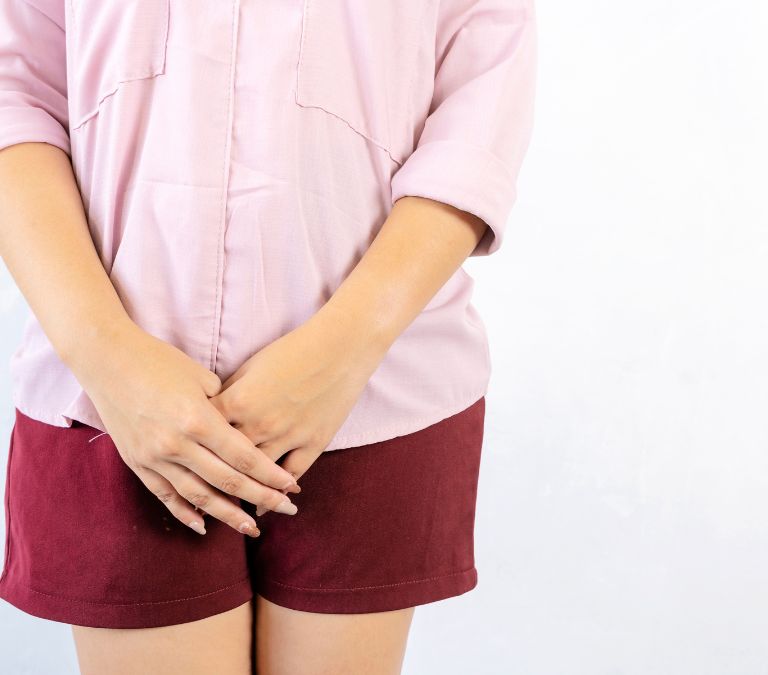Menopause makes the body change. The private regions are not left out in this transformation. One very common bodily change in the private area during menopause is vaginal atrophy. It is a thinning of the vaginal walls. Another even more common, and maybe more significant, change is vaginal laxity. Vaginal laxity is a feeling of vaginal looseness after pregnancy and vaginal delivery. Still, it can also be caused by previous pelvic surgery, menopause, and age. Because there is reduced vaginal feeling during intercourse, women with this condition typically lose sexual enjoyment. In addition, some women lose confidence, fearing that their sex life would negatively affect their relationships.
Despite its prevalence, vaginal laxity is a topic many women are ashamed of and uncomfortable discussing. Unfortunately, this causes many people to suffer in silence rather than seek help. Even fewer people discuss treatment alternatives with their doctors. That is why we are taking a concise look at this condition in this article. We are going to look at the cause and symptoms. We will also examine the treatment options for people passing through this condition.
Causes of Vaginal Laxity

- Menopause
When estrogen levels drop during menopause, the vaginal muscles become slightly less dense and lose elasticity. It results in laxity. The vaginal canal and tissues around the vaginal entry lose strength and structure. Research has shown that around half of all women report considerable vaginal laxity following menopause due to declining estrogen levels.
Several of your hormones become unbalanced during menopause, and hormone imbalance is a major factor at the beginning of this disorder in women in their menopause years.
- Vaginal Childbirth
Vaginal births can result in vaginal laxity and pelvic floor disorders due to the strain of the pregnancy. Vaginal tissue can overstretch during childbirth, breaking collagen fibers and generating a sensation of looseness around the vaginal entrance. This reduction of tightness might result in a reduced sensation and sexual satisfaction during intercourse.
The demands of pregnancy can cause alterations to the vaginal and other pelvic organs. Women who have had C-section deliveries may also not be left out. Collagen levels can fluctuate during pregnancy due to placental hormones impacting all tissues. It’s worth noting that women experiencing their first pregnancy regain vaginal strength 6 to 12 months after giving birth. However, when you have more than one child, have a large baby, or have a forceps delivery, you’re more prone to develop vaginal laxity.
- Age
As you grow older, your body’s muscles become more relaxed, including those in your vaginal area. Vaginal laxity will develop as a result of this. In addition, when muscles and tendons in the pelvic region deteriorate and offer reduced support to the vagina and other pelvic organs as we age, vaginal laxity is usually accompanied by urinary incontinence and even digestive problems.
Other clinical conditions might lead to vaginal laxity. Any condition that might result in a marked drop in body estrogen level can induce vaginal laxity in the long run. Inherited problems, such as decreased collagen production, increased body weight, and vaginal damage unrelated to childbirth, are less prevalent.
Symptoms Of Vaginal Laxity
Women may be aware that vaginal laxity is a problem. Still, they may be unaware that other symptoms they are experiencing are linked to a weak and flexible vaginal canal. You may be experiencing any of the symptoms of vaginal laxity listed below. In that case, you should seek evaluation and treatment from your healthcare professional.
- Decreased Sexual Satisfaction: Most people who present with vaginal laxity complain of a decrease in their satisfaction from sexual activities. The decline in sexual interest with age is considered normal. However, when this decline is significant and is beginning to be a source of distress, it is considered a clinical case. Vaginal laxity leads to a decrease in sexual satisfaction beyond the physical. There are a lot of psychological factors that inhibit sexual desire in women who are confronted with this condition. Therefore, treatment of the physical conditions might lead to a decrease in this symptom. It should be complemented by psychological treatment also.
- Loss of confidence: Most people who suffer from vaginal laxity also suffer regressive levels of self-confidence. These people suffer from self-consciousness, especially when sexual intercourse is involved. They are worried about what their partners would think. People who go through this condition experience embarrassing moments, like the expulsion of air sounds during intense exercise, sudden movements, or sexual intercourse. These would most definitely affect their self-confidence and limit the activities they are comfortable with. The effect is a reduced quality of life and a psychological burden to the people with this condition.
- Vaginal dryness: Since vaginal laxity in menopausal women is mainly due to the decrease in the level of estrogen present, it is usually accompanied by vaginal dryness. The walls of the vagina possess a natural lubricant maintained by the hormone – estrogen. This moisture makes sure that the vagina is healthy and can withstand stress. However, vaginal laxity and the general lack of estrogen causes the vagina to lose this lubrication. While the loss of lubrication might not sound like a big deal, it can bring major discomfort, especially during sexual intercourse. There are many treatment options available for people who are experiencing this condition.
- Pain during sexual activity: People experiencing vaginal laxity sometimes due to loss of lubrication experience painful sexual intercourse. The loss of the natural lubricant of the vagina that keeps it moist and allows it to stretch is responsible for the pain. When it leaves, it takes with it these two capabilities. When the vagina is not lubricated properly and has lost the ability to accommodate, there is corresponding pain. The consequence is that sexual intercourse becomes unpleasurable. This symptom leads to decreased sexual desire or libido in women experiencing vaginal laxity.
- Urogenital incontinence: Women experiencing vaginal laxity also risk suffering from stress urogenital incontinence. Urogenital incontinence happens when sudden physical movement puts stress on the walls of your bladder, causing the involuntary leakage of urine. Because menopausal women are more at risk of having this condition, stress urogenital incontinence is more common in women than men. Women who suffer from this condition suffer a decrease in self-confidence. They are more likely to isolate themselves. This isolation puts their work and social life in great distress. It might be a good idea to seek out a healthcare provider when this happens.
- Loss of sensation during sexual intercourse: There are two possible reasons. It has been mentioned that the apparent lack of estrogen that accompanies menopause and initiates vaginal laxity also makes the vaginal walls thin and dry. It makes for a less sensitive vagina and decreased sensation during sexual intercourse. Vaginal laxity might also lead to decreased blood flow to the pelvic floor muscles. The weakness of these muscles has also been implicated in the loss of sensation during sexual intercourse. All these are conditions that present with vaginal laxity.
Diagnosis
It’s vital to understand that there’s no one-size-fits-all method or test for determining vaginal laxity. The doctor diagnoses based on the patient’s medical history and a genital physical examination. After that, the doctor will make a treatment recommendation.
Treatment Options
After diagnosis, your healthcare provider will proffer certain treatment options. Depending on pricing and discretion, the healthcare provider will provide the options listed below to restore the vagina’s structural and functional credibility.
Hormone Replacement Therapy
A natural decline in estrogen that occurs as we age is one of the main reasons for vaginal laxity. Menopausal women experience a marked drop in their estrogen level during menopause. This decline is why HRT (Hormone Replacement Therapy) is routinely prescribed to treat vaginal laxity. Hormone replacement therapy (HRT) is a treatment that uses female hormones. During menopause, your body stops producing estrogen, so you take the prescription to replace it. Hot flashes and vaginal soreness are two frequent menopausal symptoms treated with hormone treatment.
Hormone replacement therapy (HRT) is a long-term treatment for vaginal looseness in women. Due to a decline in critical estrogen levels during pregnancy or menopause, the vaginal canal can be stretched and tissue weakened. Hormone replacement therapy can help you regain that balance and improve your sexual health significantly.
Types of Hormone Therapy
Hormone replacement therapy aims to restore the estrogen that your body stops producing after menopause. Estrogen replacement therapy is divided into two types:
- Low-dose Vaginal Products: These come in creams, tablets, and rings. They are low-dose estrogen preparations. They are used for estrogen’s local and topical administration. This option minimizes the amount of estrogen absorbed into the body. Low-dose vaginal preparations are the best for vaginal and urogenital issues associated with menopause.
- Systemic Hormone Therapy: This treatment method delivers estrogen to the entire body. The treatment includes pills, skin patches, gels, creams, spray, and ring forms. These forms of estrogen therapy deliver a higher dose of estrogen throughout the body. They are used for most menopausal symptoms.
Careful hormone therapy has been known to deal with most menopausal symptoms, including vaginal laxity. Hormone therapy has some drawbacks. These hazards vary depending on the type of hormone therapy, the time you take the drug, and your health concerns. Therefore, hormone therapy should be adjusted for individuals and regularly re-evaluated to ensure that the benefits outweigh the dangers.
- Kegels
Kegel exercises strengthen the pelvic floor muscles around the bladder, bottom, and vagina. It is one of the easiest and most effective therapies for increasing vaginal tightness.
When addressing modest vaginal laxity, kegel exercises are frequently prescribed as a first step. Kegel exercises can help tighten the muscles in the pelvic area in women who have recently given birth. Kegel exercises will not be able to help ladies with actual vaginal laxity since they do not target the tissue within the vagina or the vaginal wall. You can do them almost anywhere – at your desk, in your car, or watching TV.
The first step is to identify the muscles that need to be strengthened. For example, the muscles that stop the flow of pee are identifiable while urinating. You’re ready to begin the movement once you’ve determined which muscles to engage.
Kegels work best when the bladder is completely void of fluids. Muscles should be tightened and held for several seconds. Relax for a few moments before repeating up to ten times. Avoid tightening your buttocks or thighs when squeezing the pelvic floor muscles. It would be best if you also breathe properly.
Pelvic floor training and Kegel exercises help in tightening the vaginal muscles. Note that there is no evidence that they do so.
- Surgical Treatment
Surgical solutions are available for women with vaginal laxity and urine incontinence. This solution is for those who do not respond to laser therapy. The clinical term is surgical vaginoplasty. This type of treatment is the surgical tightening of the structures of the vagina and other surrounding structures as a treatment for vaginal laxity or to maintain aesthetics. The goal is to rebuild the vaginal wall significantly, resulting in increased friction and (ideally) more sensation during sex. The disadvantage for some individuals is that vaginoplasty requires recovery time like any reconstructive surgery. Though many women can walk easily just a few days following their treatment, it might take up to six weeks to return to work, exercise, and sexual activity.
Procedure For Surgical Vaginoplasty

The divided muscles are brought together during a vaginoplasty. The excess mucosa skin from the backside of the vagina is also removed. The surgery may require the removal of the exterior skin for a more beautiful appearance. Before surgery, patients are instructed to undergo a bowel prep.
Anesthesia is also used to prevent pain while patients undergo the process. While a vaginoplasty can be performed under a local anesthetic, most people choose general anesthesia.
Once the amount of tightening is determined, a pie-shaped wedge is marked to restrict the excess skin inside the vagina. Tightening the tissues beneath the skin is done with strong sutures. The mucosal skin is sutured closed after the vaginal canal has been tightened. If any projecting skin is visible outside, it can be reduced for a more attractive appearance. After the procedure, patients might expect to be out of commission for one to two weeks. For the first few days, they may experience severe soreness. They must refrain from using tampons or having intercourse for eight weeks. Depending on the tightening, some patients may be advised to utilize dilators.
The vaginal canal is usually tightened after this treatment. It results in improved sexual enjoyment. However, this procedure has risks. The risks may include bleeding, urogenital infections, pain, and other rare complications. Nevertheless, the satisfaction of a patient with surgical vaginoplasty is high. Some women who wish to have more children or do not want surgery may prefer to pursue nonsurgical treatments.
Vaginal Laser and RF Treatment
This particular form of treatment has been the topic of many debates. Many people question the efficacy of this particular method of vaginal tightening. In this particular treatment method, the goal is neither hormonal nor surgical. Instead, the idea is to stimulate the formation of collagen. Depending on the media of choice, the modus operandi of this process is to heat the tissues of the vaginal wall. It will cause enhanced collagen synthesis.
These procedures are relatively new and are termed vaginal rejuvenation. The important question is, do these procedures work?
A recent study indicated that RF therapy with surface cooling to protect the vaginal skin improved vaginal tightness and female sexual function.
Laser energy can replace RF. RF heats the vaginal tissues deeper. While laser energy heats them at a more superficial level. As a result, women suffering from vaginal looseness benefit greatly from laser treatment.
The dual laser technology is a type of vaginal tightening that targets the structures and surfaces of the vaginal walls. One laser induces the development of new collagen and elastin in the vaginal deeper structural tissues, resulting in thicker, stronger vaginal walls. This new tissue supports the vagina and other pelvic organs as the vaginal canal ‘tightens’ and ‘thickens.’ The second laser resurfaces the vaginal walls to promote new cell growth that is more resilient and capable of producing natural lubrication, resulting in improved vaginal function. The laser and RF therapy process lasts longer than surgery. Many healthcare practitioners suggest a treatment plan that includes a 6- to 12-month retreatment period after the initial treatment.
These treatment methods, like most nonsurgical techniques, do not replace surgery. RF and laser treatments tighten the skin by remodeling collagen. In contrast, surgery closes the space created by the vaginal muscles stretching apart. While RF and laser treatments have limited results, surgical vaginoplasty includes the dangers of surgery. These procedures come with their risks. There have been some reported cases of vaginal discharge and temporary tenderness. However, most of these were due to early intercourse after the procedure.
It is important to note here that the effects of these treatments are not permanent. So if you are looking for more permanent procedures, the right approach would be to go for the surgical vaginoplasty. However, suppose you are looking for more temporary treatment. If you are hoping to have children or do not want to brave the risks associated with surgical procedures, these treatment options might be what you are looking for.
Cognitive Behavioral Therapy

Most of the present symptoms of women suffering from vaginal laxity are based on psychological and sexual concerns. Medical personnel has started looking into the possibility of providing psychological treatment to tackle these conditions.
Psychological therapy, notably Cognitive Behavioral Therapy (CBT), is confirmed by many researchers as a low-risk treatment for menopausal symptoms. Research has demonstrated that CBT is beneficial in lowering several common symptoms. In addition, this regimen is expected to increase sexual pleasure (primary outcome), desire, arousal, relationship satisfaction, body image, vasomotor symptoms, sadness, and anxiety (secondary outcomes).
There is still a lot of research on cognitive-behavioral therapy as a tool for treating the symptoms of vaginal laxity. While this will provide a way to treat the psychological symptoms of this condition, it will also give rise to a nonsurgical solution for people who would rather not go under the knife. It would present a form of reprieve to people afraid of the side effects of hormone replacement therapy.
Vaginal laxity is a prevalent problem that often goes unnoticed and untreated. It’s one of the most common causes of female sexual dissatisfaction. The illness might damage your sexual health and self-confidence gradually and cumulatively. Vaginal looseness doesn’t have to be the be-all and end-all of your sexual well-being, whether you’re concerned by a lack of feeling during intercourse or suffer from urinary incontinence.
Vaginal laxity is a prevalent disease that affects many women. It deserves just as much attention as any other medical or health issue. Women of all ages are encouraged and recommended to get treatment to learn more about their options and improve their overall vaginal health, appearance, and function.







